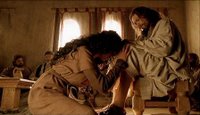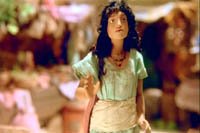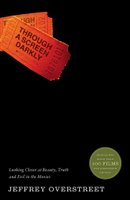 Yesterday's post
Yesterday's post got me thinking about the story of the woman who anoints Jesus. I mentioned this incident last year when looking at
From the Manger to the Cross. I've always found the varying accounts and the way they vary a bit confusing. There are numerous details in each telling and they all seem to vary significantly from each other. It's also strange because the story is one of the few that is in all four gospels, and because it is Luke's account that is the most different rather than John's as we would normally expect.
Anyway, yesterday I decided to tabulate all the incidents and see how they compare across the four gospels. The results are below, and you can view all four stories in parallel using the
Synoptic Parallels page.
| Detail | Matt 26:6-13 | Mark 14:3-9 | Luke 7:36-50 | John 12:1-8 |
| Before Passover |
| Y |
| Y |
2 Days Before
|
| Y |
|
|
6 days Before
|
|
|
| Y |
| At Bethany | Y | Y |
| Y |
| House of Simon | Y | Y | Y |
|
| (The Leper) | Y | Y |
|
|
| (The Pharisee) |
|
| Y |
|
Lazarus present
|
|
|
| Y |
| Martha serves |
|
|
| Y |
| A Woman | Y | Y | Y | Y |
| =Mary |
|
|
| Y |
| =Sinful |
|
| Y |
|
| Alabaster Jar | Y | Y |
|
|
| A pint |
|
|
| Y |
| Nard |
| Y |
| Y |
| Ointment | Y | Y | Y | Y |
| Broke jar |
| Y |
|
|
| Poured | Y | Y |
| Y |
| Tears |
|
| Y |
|
| Head | Y | Y |
|
|
| Feet |
|
| Y | Y |
| Wipes Feet |
|
| Y | Y |
| With Hair |
|
| Y | Y |
| Kissed Feet |
|
| Y |
|
Smells Fills House
|
|
|
| Y |
| Some objections.. | Y | Y | Y | Y |
| Pharisees object |
|
| Y |
|
| Disciples object | Y |
|
|
|
| Judas objects | Y |
|
| Y |
| Why not sold | Y | Y |
| Y |
| Year's wages |
|
|
| Y |
| Judas a thief |
|
|
| Y |
| Kind of Woman |
|
| Y |
|
| Leave Her Alone | Y | Y |
| Y |
| Parable & Rebuke |
|
| Y |
|
| Beautiful Thing | Y | Y |
|
|
| Day of Burial | Y | Y |
| Y |
| Always Have Poor | Y | Y |
| Y |
| Wherever Story Told | Y | Y |
|
|
| Total | 17 | 19 | 14 | 23 |

By doing this on a spreadsheet I was able to do a few comparisons. Firstly, the number of elements of the story that are common to all four gospels are startlingly few. Essentially, Jesus goes for a meal, a woman puts ointment on him and when some present object Jesus rebukes them. There are however a stack of differences. Where and when does this take place? Does the woman anoint his feet, his head or both? Who objects, and what do they object about? And what is Jesus's response.
Some of these details amalgamate quite nicely. Simon could have been a Pharisee who had contracted a skin disease at some point in his life, perhaps when he was much younger. The woman could be Mary of Bethany, who could have had a sinful life. Other details flat out contradict themselves, such as whether this took place two days before the Passover or six days before. Others could possibly co-exist, but would seem unlikely to do so. Perhaps the disciples objected because of the waste, AND Simon objected because of the woman's character.
There are a number of ways to respond to all these details. Firstly, one could decide it was all one incident. The details over timing are minimal and perhaps the woman, who was Mary of Bethany, anointed both his head and his feet with both ointment, and her tears, and wiped his feet wit her hair as well. There were two sets of objections to this behaviour, and Jesus dealt with both. This is the way the majority of harmonised Jesus films try to go, with the woman performing multiple anointings. The major problem with this is that none of the gospels describe the event in this way.
The other possibility is that there were two such events. One recorded in Matthew, Mark and John, and the other recorded in Luke. Certainly, of the 14 details mentioned by the third evangelist, the only one it shares with the other three accounts (other than those elements common to all four as listed above) is that it took place at the house of someone called Simon.

This version of events is how the film
From the Manger to the Cross chooses to show things, with two different events. There are, however, additional problems with this. Firstly, it is difficult to know how likely this is. The action seems to have been fairly shocking in it's time. Would two such women have had such a similar response, given how few similar incidents of woman responding in dramatic ways to Jesus are recorded?
Secondly, the details of the other three accounts still don't match up all that well. Of almost 40 individual details, no single account contains more than 23 (John), and Matthew only contains 17. Furthermore, if we compare them we find that although they agree the incident took place at Bethany, and that the conflict and Jesus's reprimand concerned the potential sale of the ointment for the poor, there are only 9 details which they have in common. Comparing them in pairs, Matt/Mark share 15 details, Mark/John share 11, and Matt/John share just 10.
On the other hand there is still a good deal of conflict. Mark and John conflict over when this took place, John implies (at least) that this took place in Lazarus's house, whereas Matthew and Mark say it was Simon the Leper's house. Matthew and Mark only mention Jesus's head being anointed, whereas John only mentions the feet and so on. There is of course the possibility that there were three such events (Mark/Matt's, John's and Luke's), but that would just be getting ridiculous.
Thirdly, it seems reasonably clear that when Luke is writing he is familiar at least with Mark's gospel, and possibly Matthew's as well, yet he erases their story and brings in his own. If he was aware of their incident, and another one which he prefers, why not include both? Mark was happy to do that with the two feedings of multitudes (4000, and 5000 in Mark 6 & 8), as was Matthew, although perhaps the fact that Luke was not has some significance.
Fourthly, there is again the point that none of the gospels record there being two separate incidents. Such a theory is purely conjecture, based on trying to tie up the details of the four different accounts.

How does all this relate to the films, comments about
From the Manger to the Cross not withstanding? Well firstly, what is remarkable is the number of films that add a new detail all of their own, namely that this woman is Mary Magdalene. In fact, as programmes such as
The Secrets of Mary Magdalene have pointed out, it is the confusion between this story, and those of the unnamed adulteress of
John 8, and Jesus's exorcism of Mary Magdalene (
Luke 8:2), that led to Magdalene being labelled a repentant sinner.
Labels: Gospel Comparisons, Living Bible, Mary Magdalene























































